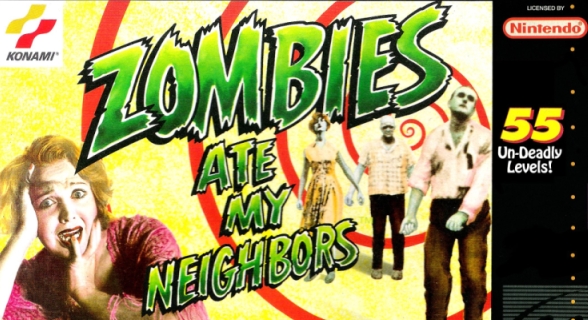
A moderately belated Mojo review
The golden days of LucasArts were categorized by the variety and consistent quality of its games. I'm not just talking about our beloved graphic adventures, mind you. From the early Star Wars releases, such as TIE Fighter, to the occasional non-SCUMM original title, just about everything that came out of LEC in the early 90s was high caliber. One of these lesser known originals was the console gem Zombies Ate My Neighbors, whose recent addition to Nintendo's Virtual Console library on the Wii has granted it a much deserved second life a decade and a half after its original release. The years have been surprisingly kind.
Published by Konami and developed by LucasArts, Zombies Ate My Neighbors hurtles you into a world overrun by the undead, an infestation possibly extra-terrestrial in cause. This apocalyptic scenario is faced head-on by a pair of trendy and well-armed teenagers named Zeke and Julie, who cheerfully embrace their volunteer roles as eradicators. Throughout locations ranging from suburban neighborhoods to shopping centers, Egyptian pyramids and haunted castles, the player's job is to navigate around the maze-like settings and nab as many hapless civilians as they can before the risen dead do while wasting the copious monsters and collecting ammo and other useful items. Staying alive also factors in.
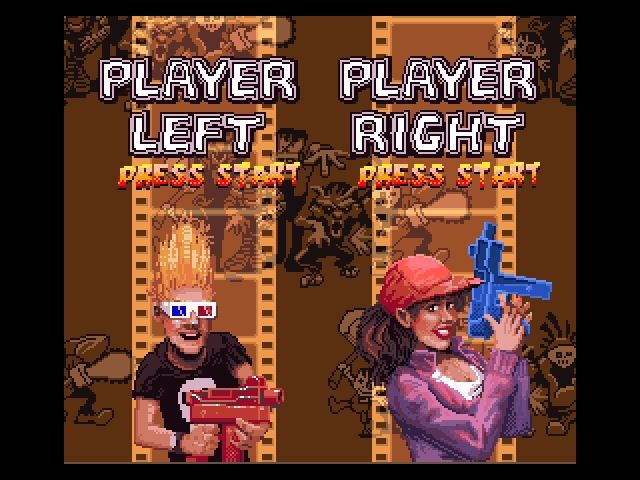
If the title didn't clarify the tone of the whole production, this is all executed in a fun, tongue-in-cheek send-up of B-grade scifi movies with a charming cartoonish style. The humor extends to the arsenal of weapons and items at your disposal, from the default water gun (filled with holy water, of course) to soda pop, bazookas, and weedeaters. The diverse array of items range from standard fare like first aid kits, keys used to unlock doors (though a bazooka will work just fine as a substitute), silverware, inflatable clowns, the infamously devastating Pandora's Box, and potions that temporarily turn you into a beefy, invincible purple monster. The enemies cover a similarly wacky spectrum, from classically depicted zombies to lightning fast, axe-wielding midgets, chainsaw-wheeling psychos, carnivorous plant life, werewolves, mummies, mutated blobs, three hundred foot babies, and more. There's even a level where the game makes all of the zombies look exactly like you and your partner (if you're playing co-op, which you should be) in an attempt to psyche you out. Even putting aside the solid gameplay, Zombies succeeds at being pretty amusing strictly from a presentation standpoint.
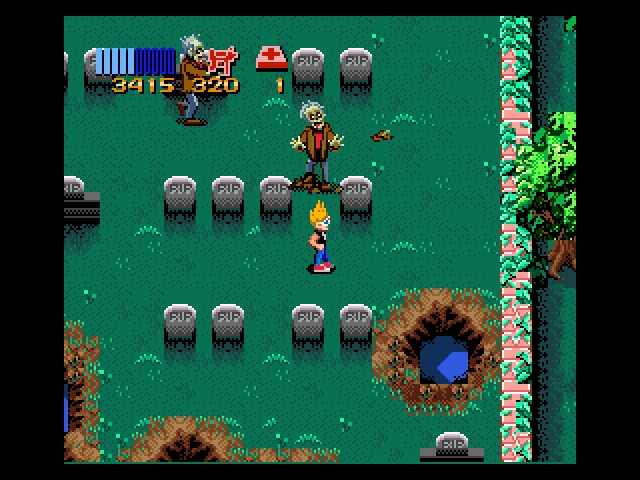
But it's the gameplay where Zombies truly excels. Simple and addictive, there's a classic arcade feel to the mayhem, with the accessibility of the controls keeping you hooked despite the harsh and exponentially increasing difficulty. The game is a "3/4" top-down shoot 'em up where your time is spent frantically shooting enemies and collecting stuff. There's a level of exploration, but there's not a whole lot of time to take a breath. Levels are completed by walking through an exit door that appears when all of the neighbors are gone, either by your rescuing them or failing to. Although playing for survival rather than heroism is tempting, the game doesn't mess around when it comes to the player's resource management responsibilities; you have no chance of getting through the later levels without wisely stocking up on items and bonus points early on, which makes the password system fairly useless for returning anywhere but the first handful of stages. The bountiful cheat passwords, on the other hand, find a whole lot of use.
The password system can also be used to reach a few bonus levels, including one with a Day of the Tentacle theme. (The two games were in production side-by-side and in fact the B-movie-adulating Zombies fits fairly comfortably in the Maniac Mansion universe.) The in-joke themed bonus levels even include one that takes place inside the LucasArts offices themselves, where the developers are available for chatting. Called "Monsters Among Us," it's one of very few opportunities to see George Lucas and an Indy-clad Steve Purcell rendered as 16-bit sprites that life's likely to throw on your lap.
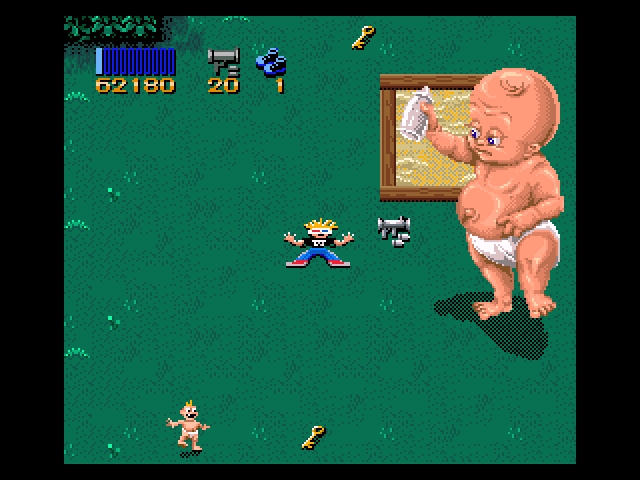
Although the game holds up remarkably well thanks to a pleasing style and winning gameplay (even the music, composed by George Sanger, is relatively memorable), there's a point about halfway through the fifty-six levels where it suddenly seems to run out of ideas and becomes very repetitive. The difficulty level also completely jumps the rails – those looking for an incredibly stiff challenge will get it, but most players will become frustrated with the game far before they reach the arduous conclusion. And though the single player mode isn't worthless (and probably your best chance at getting all the way through), the selling point really is the two player co-op, which is truly a blast when you're not coming to blows with your partner over health pack entitlement or getting inadvertently killed by a hedge-cutting maniac because player two is dawdling on the opposite side of the screen or helplessly caught behind an obstruction.
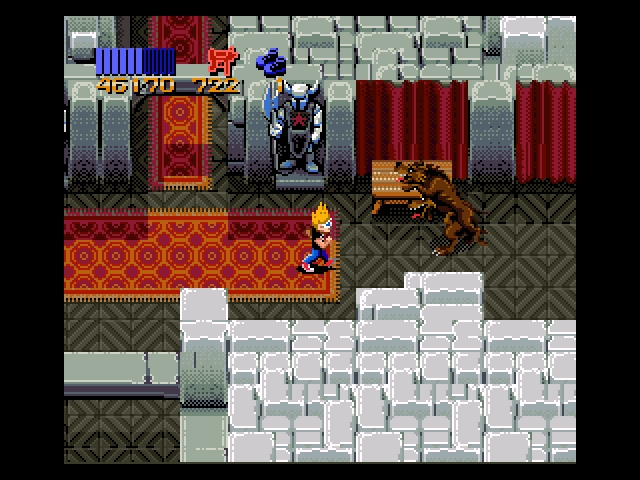
The game's project leader was Mike Ebert, an artist whose work you're familiar with if you've ever played Indiana Jones and the Last Crusade, Indiana Jones and the Fate of Atlantis, The Secret of Monkey Island, or the Nintendo port of Maniac Mansion. Ebert and fellow employee Kalani Streicher (Loom) actually tried repeatedly to make their own SCUMM games, but the cancellation of the Loom sequel and unfavorable company politics conspired to keep them from ever landing lead positions on a successful adventure project. Streicher went on to head Zombies' completely forgotten sequel, Ghoul Patrol, which has nearly identical gameplay if somewhat diminished charm, while Ebert followed up with a similarly superb and underappreciated SNES game called Metal Warriors. Alas, the sidescroller was released too late in the system's lifespan for anyone to know about it. He then left LEC to found his own studio, Big Ape Productions, which developed for LEC Herc's Adventures, which is essentially the unofficial second sequel to Zombies, only this time around with a Greek mythology theme. Tracking down the aforementioned games is a recommended endeavor, and hopefully they join Zombies in getting a secure home in the downloadable space, where they may finally find the expanded audience they deserve.
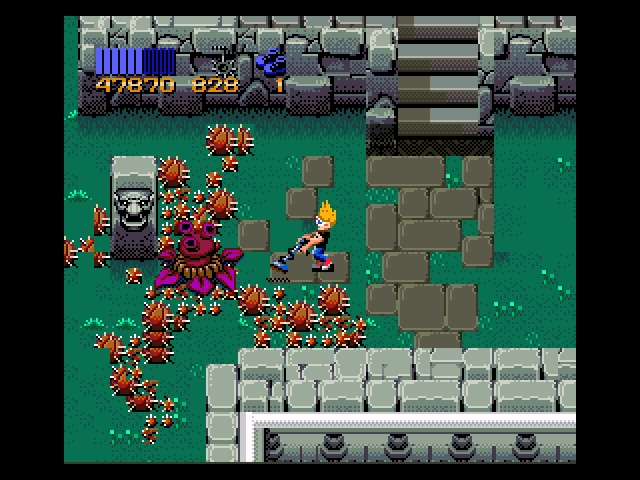
Originally released for the Super Nintendo and Sega Genesis (the two versions are essentially identical) in 1993, Zombies Ate My Neighbors was critically acclaimed and has over the years earned a reputation as a cult classic. While the Genesis version got a re-release on a Dreamcast disc several years back, the game has been long unavailable until the SNES version's recent appearance on the Virtual Console. For $8, the game is very much worth your attention if you're a Wii owner. If you're not, but you still own a dusty 16-bit console, you can probably find the game on the cheap on eBay. However you procure it, Zombies Ate My Neighbors is a game you owe to yourself to either discover or rediscover, and is as representative as anything of the kind top-notch entertainment LEC used to be able to pump out for any given genre.
A review by Jason, whose childhood was traumatized by those shrieking, axe-wielding little pricks who continue to inflict damage as flaming remnants even after you’ve killed them. Dammit.

Pros: Solid, highly addictive gameplay; generous length; amusing visual style; co-up mode is a complete blast
Cons: Gets quite repetitive by the end; difficulty level quickly abandons rationality
Looking to be recomended some supplemental reading material? There are some fine developer reflections on the game in Gamasutra’s interview with Mike Ebert from a few years back. For a full list of passwords for either version of the game check out GameFAQs, and for copies of Ghoul Patrol, Herc’s Adventures or Metal Warriors head on over to eBay. There's also a strangely addictive musical remix by "NoppZ" to be consumed over at MojoArt.
